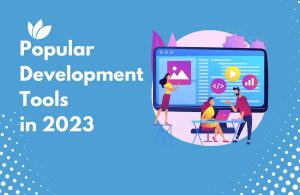In the fast-paced world of software development, choosing the right tools can make all the difference between success and struggle. With the ever-expanding array of options available, it’s crucial to understand the different types of software development tools and select the ones that align with your project’s needs and goals. In this blog post, we will explore the key factors to consider when choosing software development tools, provide an overview of popular tools in 2023, and showcase case studies and examples of successful tool usage.
Table of Contents
ToggleIntroduction
Effective software development relies on utilizing the right tools for the job. The choice of tools can impact productivity, code quality, collaboration, and project success. By understanding the importance of selecting the right software development tools, you can set yourself up for efficient and successful development processes.
Understanding Different Types of Software Development Tools
Software development tools can be categorized into various types based on their purpose and functionality. Some common categories include code editors, version control systems, project management tools, containerization platforms, and continuous integration/continuous delivery (CI/CD) tools. Each category serves a specific purpose and offers unique benefits for the development lifecycle.
Factors to Consider When Choosing Tools
When evaluating software development tools, several factors should be taken into account to ensure the best fit for your project. These factors include:
- Compatibility with Technology Stack: Ensure that the tools are compatible with your project’s technology stack and programming languages.
- Ease of Use and Learning Curve: Consider the learning curve and ease of use of the tools to minimize the time spent on training and onboarding.
- Scalability and Extensibility: Choose tools that can scale with your project’s growth and easily integrate with other tools in your development ecosystem.
- Community Support and Documentation: Check the availability of vibrant communities, active forums, and comprehensive documentation, as they can provide valuable support and resources.
- Cost and Licensing: Consider the cost implications and licensing terms associated with the tools, ensuring they align with your project’s budget and licensing requirements.
Overview of Popular Tools in 2023

In 2023, several software development tools gained popularity due to their features, performance, and community support. Here’s a brief overview of some widely used tools:
- Visual Studio Code: A versatile and lightweight code editor known for its extensive customization options, rich extension ecosystem, and excellent support for various programming languages.
- Git: A widely adopted distributed version control system that enables efficient collaboration, code versioning, and branching strategies.
- Jira: A powerful project management tool that helps teams plan, track, and release software projects, providing features for issue tracking, agile boards, and team collaboration.
- Docker: A containerization platform that simplifies the process of creating, deploying, and running applications in isolated environments, enabling scalability and consistency across different environments.
- Jenkins: A leading open-source CI/CD tool that automates the build, test, and deployment processes, enabling continuous integration and delivery.
Case Studies or Examples of Successful Tool Usage
To further illustrate the benefits of using these tools, let’s explore some real-world examples:
- Case Study: Efficient Coding with Visual Studio Code
A software development company improved their coding efficiency by leveraging Visual Studio Code’s intuitive interface, powerful debugging capabilities, and extensive language support. The streamlined workflow and productivity features allowed developers to focus more on writing quality code.
- Example: Improved Version Control with Git
A development team adopted Git for their version control needs. This enabled them to effectively manage code changes, collaborate seamlessly, and maintain a centralized repository. Features such as branching and merging facilitated efficient collaboration and simplified the code review process.
- Scenario: Effective Project Management with Jira
A software development team utilized Jira for project management, enabling them to plan, track, and prioritize tasks effectively. The agile boards and customizable workflows provided transparency and facilitated smooth communication among team members, leading to improved project delivery.
- Instance: Benefits of Using Docker for Application Deployment
A startup leveraged Docker for their application deployment to ensure consistent environments across development, testing, and production stages. By encapsulating their applications and dependencies within containers, they achieved seamless deployment, scalability, and portability.
- Success Story: Continuous Integration and Delivery with Jenkins
A software organization embraced Jenkins for their CI/CD pipeline, automating build, test, and deployment processes. By adopting a continuous integration and delivery approach, they significantly reduced manual errors, accelerated release cycles, and improved overall software quality.
Conclusion
Choosing the right software development tools is essential for successful project delivery and team collaboration. By understanding different types of software development tools, considering important factors when making tool selections, and exploring popular tools, you can optimize your development processes and stay ahead in the ever-evolving world of software development. Remember, the right tools, combined with expertise and best practices, can empower you to create remarkable software solutions.
Frequently Asked Questions
- What are the top 5 software development tools in 2023?
In 2023, popular tools include Visual Studio Code, Git, Jira, Docker, and Jenkins due to their robust features, performance, and extensive community support.
- What factors to consider when choosing software development tools?
Key factors include compatibility with your technology stack, ease of use, scalability, community support, and cost and licensing terms.
- Why is community support important for software development tools?
Community support provides access to valuable resources, problem-solving, and best practices, contributing to a tool’s continuous improvement and user success.
- How does Docker benefit application deployment?
Docker encapsulates applications and dependencies in containers, ensuring consistent environments and facilitating seamless deployment, scalability, and portability.
- What role does Jenkins play in CI/CD?
Jenkins automates the build, test, and deployment processes, enabling continuous integration and delivery, reducing manual errors, and accelerating release cycles.





